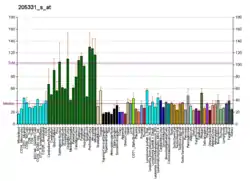REEP2
Receptor expression-enhancing protein 2 is a protein that in humans is encoded by the REEP2 gene.[5][6]
Function
The protein encoded by REEP2 belongs to a family of proteins with receptor enhancing expression capabilities, including possible enhancement of G protein-coupled receptors.[7] The REEP2 protein shows a restricted mode of expression in human tissues.[8]
Clinical significance
REEP2 mutations have been reported in families with hereditary spastic paraplegia.[9]
References
- GRCh38: Ensembl release 89: ENSG00000132563 - Ensembl, May 2017
- GRCm38: Ensembl release 89: ENSMUSG00000038555 - Ensembl, May 2017
- "Human PubMed Reference:". National Center for Biotechnology Information, U.S. National Library of Medicine.
- "Mouse PubMed Reference:". National Center for Biotechnology Information, U.S. National Library of Medicine.
- Clark, Adrian J.L.; Metherell, Louise A.; Cheetham, Michael E.; Huebner, Angela (2005). "Inherited ACTH insensitivity illuminates the mechanisms of ACTH action". Trends in Endocrinology & Metabolism. 16 (10): 451–457. doi:10.1016/j.tem.2005.10.006. PMID 16271481. S2CID 27450434.
- Saito, Harumi; Kubota, Momoka; Roberts, Richard W.; Chi, Qiuyi; Matsunami, Hiroaki (2004). "RTP Family Members Induce Functional Expression of Mammalian Odorant Receptors". Cell. 119 (5): 679–691. doi:10.1016/j.cell.2004.11.021. PMID 15550249. S2CID 13555927.
- Björk, Susann; Hurt, Carl M.; Ho, Vincent K.; Angelotti, Timothy (2013-12-17). "Correction: REEPs Are Membrane Shaping Adapter Proteins That Modulate Specific G Protein-Coupled Receptor Trafficking by Affecting ER Cargo Capacity". PLOS ONE. 8 (12): 10.1371/annotation/6f86410c-63c3-4fcd-b1cb-9fd8d2ea95d0. doi:10.1371/annotation/6f86410c-63c3-4fcd-b1cb-9fd8d2ea95d0. ISSN 1932-6203. PMC 3867549.
- Uhlén, Mathias; Fagerberg, Linn; Hallström, Björn M.; Lindskog, Cecilia; Oksvold, Per; Mardinoglu, Adil; Sivertsson, Åsa; Kampf, Caroline; Sjöstedt, Evelina (2015-01-23). "Tissue-based map of the human proteome". Science. 347 (6220): 1260419. doi:10.1126/science.1260419. ISSN 0036-8075. PMID 25613900. S2CID 802377.
- Esteves, Typhaine; Durr, Alexandra; Mundwiller, Emeline; Loureiro, José L.; Boutry, Maxime; Gonzalez, Michael A.; Gauthier, Julie; El-Hachimi, Khalid H.; Depienne, Christel (2014). "Loss of Association of REEP2 with Membranes Leads to Hereditary Spastic Paraplegia". The American Journal of Human Genetics. 94 (2): 268–277. doi:10.1016/j.ajhg.2013.12.005. PMC 3928657. PMID 24388663.
Further reading
- Maruyama K, Sugano S (January 1994). "Oligo-capping: a simple method to replace the cap structure of eukaryotic mRNAs with oligoribonucleotides". Gene. 138 (1–2): 171–4. doi:10.1016/0378-1119(94)90802-8. PMID 8125298.
- Andersson B, Wentland MA, Ricafrente JY, Liu W, Gibbs RA (April 1996). "A "double adaptor" method for improved shotgun library construction". Analytical Biochemistry. 236 (1): 107–13. doi:10.1006/abio.1996.0138. PMID 8619474.
- Yu W, Andersson B, Worley KC, Muzny DM, Ding Y, Liu W, Ricafrente JY, Wentland MA, Lennon G, Gibbs RA (April 1997). "Large-scale concatenation cDNA sequencing". Genome Research. 7 (4): 353–8. doi:10.1101/gr.7.4.353. PMC 139146. PMID 9110174.
- Suzuki Y, Yoshitomo-Nakagawa K, Maruyama K, Suyama A, Sugano S (October 1997). "Construction and characterization of a full length-enriched and a 5'-end-enriched cDNA library". Gene. 200 (1–2): 149–56. doi:10.1016/S0378-1119(97)00411-3. PMID 9373149.
- Lai F, Godley LA, Joslin J, Fernald AA, Liu J, Espinosa R, Zhao N, Pamintuan L, Till BG, Larson RA, Qian Z, Le Beau MM (January 2001). "Transcript map and comparative analysis of the 1.5-Mb commonly deleted segment of human 5q31 in malignant myeloid diseases with a del(5q)". Genomics. 71 (2): 235–45. doi:10.1006/geno.2000.6414. PMID 11161817.
This article is issued from Wikipedia. The text is licensed under Creative Commons - Attribution - Sharealike. Additional terms may apply for the media files.




